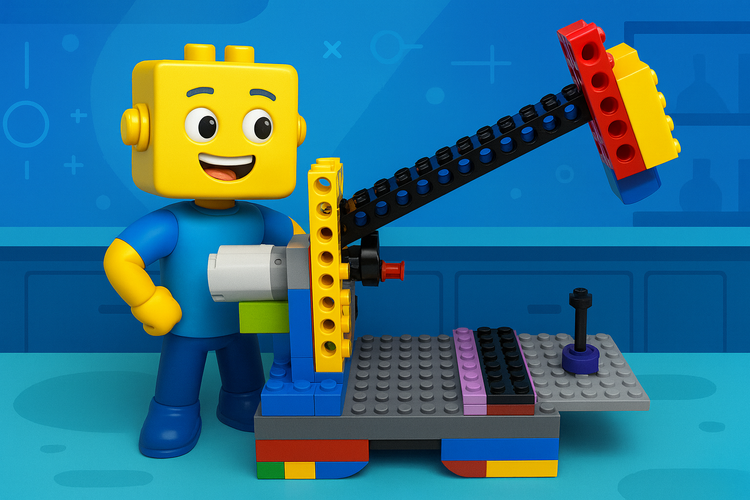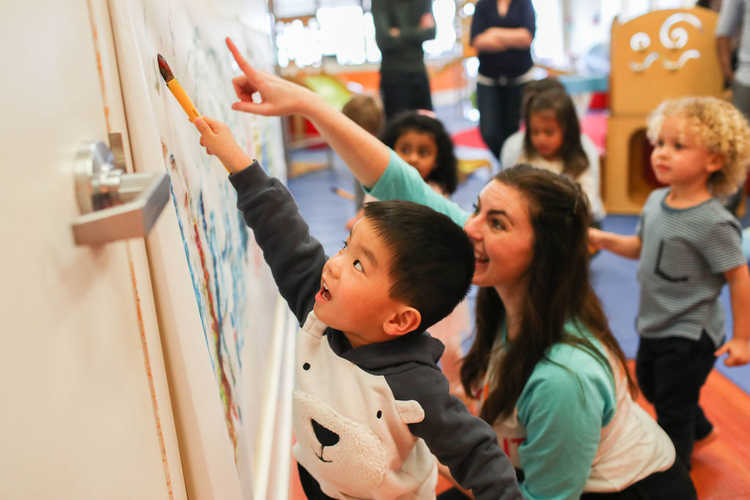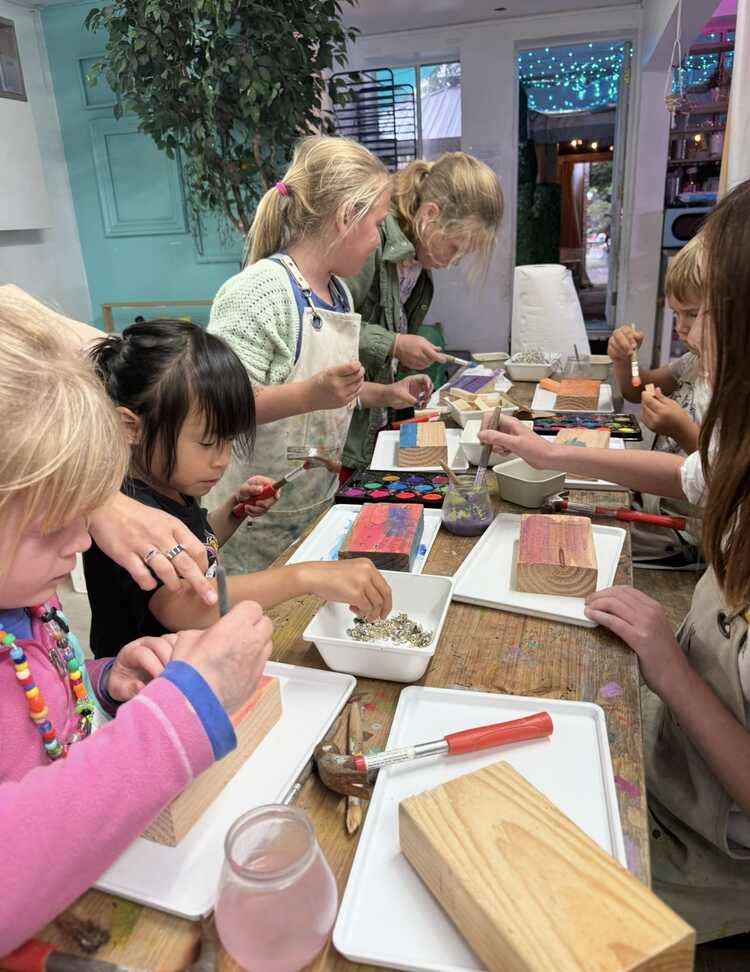STEM Programs Near Me

IntelliBricks STEM in Kitchen
100%
by IntelliBricks
Rocklin, CA
In STEM in the Kitchen, students blend creativity, science, and culinary skills as they explore how ingredients come together to create delicious results. Each session features a fun, age-appropriate recipe that reinforces basic STEM concepts like measuring, temperature, and chemical changes—all through low-flame or no-flame cooking that’s safe and classroom-friendly. We provide all ingredients, including fresh items, and all necessary cooking equipment. Only the instructor will operate the induction stove and oven. Recipes will not include common food allergens.
In-person
Ages 9-12 years

Speech and Language Group (Ages 7-9)
by FUNdamentals, LLC
East Providence, RI
SPEECH & LANGUAGE GROUP Led by Kristyn Sequeira — M.S. CCC-SLP | 12+ Years of Experience This interactive speech and language group is designed to support children who need a boost in understanding and using spoken language. Through fun, purposeful activities, children work on expanding vocabulary, forming longer sentences, retelling stories, sequencing events, following multi-step directions, and engaging in meaningful conversations. Each session is tailored to your child’s individual language goals and includes: - Play-based activities that make learning language fun - Evidence-based strategies to improve comprehension and expression - Support for social interaction, turn-taking, and functional communication This group builds foundational skills that support success at school, at home, and in everyday life. If your child could benefit from extra support in expressive and receptive language, this is a wonderful opportunity to grow in a nurturing, supportive setting. *For the greatest therapeutic benefit, it is highly encouraged that families register for at least 4 consecutive sessions. Consistent attendance supports skill development, continuity of care, and measurable progress in speech and language goals. Payment & Policies 1. All sessions are privately paid. We do not accept insurance. 2. A Superbill can be provided upon request for you to submit to your insurance for potential reimbursement. 3. Full payment is required prior to attending each session. Requirements for Participation: - A signed waiver for all participants - Sessions must be booked at least 24 hours in advance - Socks are required for both children and adults
In-person
Ages 4-6 years

Sensory Motor Group (Ages 7-9)
by FUNdamentals, LLC
East Providence, RI
SENSORY-MOTOR GROUP Led by Kelly McDonald — M.S. in Occupational Therapy | 20 Years of Experience Our Sensory Motor Group supports young children in building the foundational skills they need for play, learning, and everyday life—through a playful approach. Led by a licensed pediatric occupational therapist, this small group helps children strengthen: 🌟 Sensory processing and self-regulation 🌟 Fine motor skills (cutting, grasping, pre-writing) 🌟 Core strength, balance, and coordination 🌟 Following directions and daily routines 🌟 Emotional regulation and expressing feelings 🌟 Social skills and making friends Each session includes movement, sensory-rich play, calming strategies, crafts, and games that help children learn to understand their bodies, manage big feelings, and interact positively with peers. Perfect for children who need support with sensory processing, experience big emotions, or benefit from extra help with focus, transitions, or motor skills—in a nurturing and fun environment. ★ This class meets once a week for 4 consecutive weeks. 👉 First-time families may try one introductory class at a discounted rate ($25)! If you and your child find it to be a good fit, you are invited to register for a 4-class consecutive package. These sessions build on each other to offer maximum benefit through consistent participation.
In-person
Ages 7-9 years

On-site Winter Camp - Movie making with Scratch 2025
71%
by Siliconvalley4U
San Mateo, CA
"Kickstart Your Coding Journey with Scratch – This winter! SiliconValley4U's Scratch winter Camp for Beginners Ready to create your own stories, games, and animations? Our Scratch Winter Camp is the perfect way for young coders to get started! Designed especially for beginners, this fun and interactive camp introduces students to the world of coding through Scratch, a visual programming language built for creativity. Campers will learn the fundamentals of programming, explore game and animation design, and bring their own ideas to life—all while having a blast with fellow campers! Whether your child is curious about coding or loves storytelling and design, this camp is a great way to build confidence and spark creativity. Join us in person this winter and start creating with Scratch! Sign up today—spots are filling fast!"
In-person
Ages 6-18 years

On-site Winter Camp - Movie Making with Scratch 2025
71%
by Siliconvalley4U
San Mateo, CA
"Kickstart Your Coding Journey with Scratch – This Winter! SiliconValley4U's Scratch Winter Camp for Beginners Ready to create your own stories, games, and animations? Our Scratch Winter Camp is the perfect way for young coders to get started! Designed especially for beginners, this fun and interactive camp introduces students to the world of coding through Scratch, a visual programming language built for creativity. Campers will learn the fundamentals of programming, explore game and animation design, and bring their own ideas to life—all while having a blast with fellow campers! Whether your child is curious about coding or loves storytelling and design, this camp is a great way to build confidence and spark creativity. Join us in person this winter and start creating with Scratch! Sign up today—spots are filling fast!"
In-person
Ages 6-18 years

IntelliBricks Lego® Animal Bots & Motion Machines
100%
by IntelliBricks
Roseville, CA
Playful Builds with Purposeful Motion This LEGO® Robotics theme brings animals, tools, and quirky inventions to life through mechanical movement and creative design. Students will build robots that mimic real-world creatures and mechanisms—like a playful sea lion or a working hand drill—while using motors, sensors, and beginner-friendly coding to control them. These builds combine fun, function, and motion using rare LEGO® elements, helping students explore the intersection of nature, machines, and imagination. Disclaimer: Students will not take home any LEGO® kits, parts, or creations. This program is not affiliated with, endorsed by, or sponsored by the LEGO Group.
In-person
Ages 6-10 years

IntelliBricks Lego® Minecraft Animation
100%
by IntelliBricks
Rocklin, CA
The LEGO® Minecraft Class is an exciting and educational experience into the world of stop-motion animation production. Using LEGO® building sets based off of the Minecraft theme, students will stage their own scenes from a storyboard and take photos of the scene to tell a story. Then they will edit the images in the Frames 6 animation software where they will add effects, sound and more. Some of the features of the class include: Working in teams to collaborate and create animation projects for each day.A new and unique Minecraft theme for each day, including castle, cave and End worlds.Use of illustrated storyboards to plan out the narrative of the project Photography of the LEGO® sets in action to create slides for stop-motion animation Computer animation software to edit images using green screen, effects and sound Finished projects will be emailed to the parents end of the 6 weeks session. (Please note: IntelliBricks will provide all LEGO® and computers for the class. Children cannot take home any of their creations or LEGO® products. LEGO® group of companies does not sponsor, authorize or endorse any of our programs.)
In-person
Ages 7-12 years
sibling discount

Parent Night Out PNO 12/22
99%
by All Things Art Studio
St. Charles, IL
Parent Night Out will take place on selected evenings of every month from 6:00 - 8:30 pm (or as noted) and will incorporate many types of fine arts over the course of the school year....visual arts. All while parents enjoy a night out! Cost per event is $40 per child, $37 for additional children FROM THE SAME FAMILY. Kids will enjoy 2.5 hours of Art and Art related Activities!Parent Night Out is designed for parents to drop off kids while they go out for a dinner, meet up with friends, run errands or enjoy some alone time :) Parent Night Out... aka PNO... is a drop off program & for ages 4 and older. A teacher led art project, a fun themed craft, time for a snack (please bring your own snack & water) are included in our 2.5 hours together. Kids enjoy stations as well as several art projects during their 2.5 hours of fun at the Art Studio! Groups will be separated by age & grade level, so students can make new friends and work on age appropriate art projects. Every Day is a different theme, so you can sign up for every week :) Discounts apply when you sign up for several classes at one time. ***Bring peanut free snack & water bottle
In-person
Ages 4-14 years

School Skills-Drop Off Class
100%
by Gymboree Play & Music, Rochester Hills
Rochester, MI
School Skills is an independent drop-off program to build literacy, confidence and social skills needed for preschool, kindergarten and beyond. Children will be participating in tactile activities, story time discussions, music and movement, science experiments, constructing art projects and much much more! Purchase the corresponding pass or membership, THEN reserve your child's spot in the desired class(es) to be attended. You will then be emailed additional information and waivers to sign before your child can attend class.
In-person
Ages 3-5 years

IntelliBricks Lego® Animal Bots & Motion Machines
100%
by IntelliBricks
Rocklin, CA
Playful Builds with Purposeful Motion This LEGO® Robotics theme brings animals, tools, and quirky inventions to life through mechanical movement and creative design. Students will build robots that mimic real-world creatures and mechanisms—like a playful sea lion or a working hand drill—while using motors, sensors, and beginner-friendly coding to control them. These builds combine fun, function, and motion using rare LEGO® elements, helping students explore the intersection of nature, machines, and imagination. Disclaimer: Students will not take home any LEGO® kits, parts, or creations. This program is not affiliated with, endorsed by, or sponsored by the LEGO Group.
In-person
Ages 6-10 years
sibling discount

February Break Cooking Day Camp
100%
by Culinary Artistas
San Francisco, CA
Join us for a special day of cooking, playing, crafting, and tasting! Kid-chefs will get to craft their own breakfast, lunch, and sweet snack throughout the day, spend time outdoors, create fun food-inspired art, and much more! General Schedule: 9:00-9:30 am - Arrivals & Activity Centers I 9:30-10:00 am - Circle Time, Story + Stretching 10:00-11:30 am - Cooking Activity 1 + Brunch 11:30-12:45 pm - STEM Activity + Cooking Activity II 12:45-1:15 pm - Lunch + Quiet Time 1:30-2:30 pm - Outdoor Play and/or Art Projects 2:30-2:45 pm - Snack 2:45 - 3:00 pm - Sharing Circle and Pick-Up Max of 26 students in this camp.
In-person
Ages 4-10 years

WINTER WONDERLAND ( 4-8 YEARS OLD)
100%
by Messy Art Lab
San Francisco, CA
Each activity will encourage imagination, mindfulness, and appreciation for the world outside. It’s the perfect way to embrace all the season’s wonders - Drop off starts at 9:00am. - Pick up is 2:45pm to 3:00pm. - Aftercare hours available 3pm-5pm - Our aftercare can be purchased as a series package, we will not be offering aftercare on FRIDAYS. If you’re looking for individual days, please email ximena@messyartlab.com for individual aftercare days. What to Bring.... No NUTS or nut products are allowed at our program. -Two healthy snacks ( morning and afternoon) -Lunch (Please DO NOT pack sugary drinks, gum, or sweets) -A refillable water bottle -Comfortable clothes that can get messy and stained. -Please send your child with a jacket, sunhat, and layers. -Please put sunscreen on your child BEFORE camp. - A pair of extra clothing. Requirements : - 5-8 years old ( NO EXCEPTIONS) - Children must be ready to follow safety guidelines and engage in their projects for 30 minutes or more. - Children must be fully potty-trained and capable of handling their bathroom needs independently. - Any medical conditions (such as allergies or diabetes) and/or behavioral needs (neurodiversity, trauma) your child may have must be informed during the sign-up process. This information will help us make any necessary preparations and provide a supportive and enjoyable environment for everyone. Please note that all information shared is kept confidential. The policy for Messy Art Lab Camps refund and cancellations is as follows: - 100% refund for cancellations within 24 hours of registration. - All enrollment fees include a non-refundable deposit of 20%. - Refund of enrollment fee minus 20% non-refundable deposit if cancellation is made prior to 30 days of session start date. - No refund for cancellations made within 30 days of session start date, unless the spot is filled, in which case a refund credits minus the 20% non-refundable deposit will be issued. - Cancellations must be requested in writing via email. - Approval for transfer of camp week to another week will be determined on a case-by-case basis and per availability, with a penalty fee of 20% non-refundable deposit if made within 30 days of original camp week start date.
In-person
Ages 4-8 years
multi-purchase discount

Tuesday Art Class
by Art Zone Children's Studio
Hermosa Beach, CA
Program Highlights Pre-Class Play: Kids enjoy a 30-minute downtime to unwind before the art program begins. Engaging Art Projects: Each day features a teacher-led art project, designed based on the kids’ interests and curiosity. Homework Support: We offer support with homework if needed. Just ask! Join us for a fun and enriching art experience where creativity thrives and every child’s voice is heard. For more information and to register, visit our website or contact us directly. Looking forward to creating art with your child!
In-person
Ages 4-11 years

Winter 2025: High School Multimedia
99%
by All Things Art Studio
St. Charles, IL
This combination class offers children a sampling of art projects using various media such as painting, clay, watercolors, collage, and pastels. It is amazing what you can create when you explore with your imagination. A variety of materials are used to create your many masterpieces – Many projects are “built upon” each class, so that students experience a variety of mediums and take home several projects. Projects are new every session, so sign-up for all sessions OR our school program for discounted rate. Drawing Class This drawing class is designed for students of all levels of drawing experience, and would like to learn some advanced techniques and explore new mediums. Many projects are “built upon” each class, so that students experience a variety of mediums and take home several projects.
In-person
Ages 11-18 years

Winter 2025: Everything Art Classes (Elementary K-5) Saturday
99%
by All Things Art Studio
St. Charles, IL
This combination class offers children a sampling of art projects using various media such as painting, clay, watercolors, collage, and pastels. It is amazing what you can create when you explore with your imagination. A variety of materials are used to create your many masterpieces – Many projects are “built upon” each class, so that students experience a variety of mediums and take home several projects. Projects are new every session & seasonal, so sign-up for all sessions.
In-person
Ages 5-13 years
sibling discount

Parent Night Out PNO 4/2 Spring Break
99%
by All Things Art Studio
St. Charles, IL
Parent Night Out will take place on selected evenings of every month from 6:00 - 8:30 pm (or as noted) and will incorporate many types of fine arts over the course of the school year....visual arts. All while parents enjoy a night out! Cost per event is $40 per child, $37 for additional children FROM THE SAME FAMILY. Kids will enjoy 2.5 hours of Art and Art related Activities!Parent Night Out is designed for parents to drop off kids while they go out for a dinner, meet up with friends, run errands or enjoy some alone time :) Parent Night Out... aka PNO... is a drop off program & for ages 4 and older. A teacher led art project, a fun themed craft, time for a snack (please bring your own snack & water) are included in our 2.5 hours together. Kids enjoy stations as well as several art projects during their 2.5 hours of fun at the Art Studio! Groups will be separated by age & grade level, so students can make new friends and work on age appropriate art projects. Every Day is a different theme, so you can sign up for every week :) Discounts apply when you sign up for several classes at one time. ***Bring peanut free snack & water bottle
In-person
Ages 4-14 years
sibling discount

Parent Night Out PNO 3/14
99%
by All Things Art Studio
St. Charles, IL
Parent Night Out will take place on selected evenings of every month from 6:00 - 8:30 pm (or as noted) and will incorporate many types of fine arts over the course of the school year....visual arts. All while parents enjoy a night out! Cost per event is $40 per child, $37 for additional children FROM THE SAME FAMILY. Kids will enjoy 2.5 hours of Art and Art related Activities!Parent Night Out is designed for parents to drop off kids while they go out for a dinner, meet up with friends, run errands or enjoy some alone time :) Parent Night Out... aka PNO... is a drop off program & for ages 4 and older. A teacher led art project, a fun themed craft, time for a snack (please bring your own snack & water) are included in our 2.5 hours together. Kids enjoy stations as well as several art projects during their 2.5 hours of fun at the Art Studio! Groups will be separated by age & grade level, so students can make new friends and work on age appropriate art projects. Every Day is a different theme, so you can sign up for every week :) Discounts apply when you sign up for several classes at one time. ***Bring peanut free snack & water bottle
In-person
Ages 4-14 years
sibling discount

Parent Night Out PNO 4/24
99%
by All Things Art Studio
St. Charles, IL
Parent Night Out will take place on selected evenings of every month from 6:00 - 8:30 pm (or as noted) and will incorporate many types of fine arts over the course of the school year....visual arts. All while parents enjoy a night out! Cost per event is $40 per child, $37 for additional children FROM THE SAME FAMILY. Kids will enjoy 2.5 hours of Art and Art related Activities!Parent Night Out is designed for parents to drop off kids while they go out for a dinner, meet up with friends, run errands or enjoy some alone time :) Parent Night Out... aka PNO... is a drop off program & for ages 4 and older. A teacher led art project, a fun themed craft, time for a snack (please bring your own snack & water) are included in our 2.5 hours together. Kids enjoy stations as well as several art projects during their 2.5 hours of fun at the Art Studio! Groups will be separated by age & grade level, so students can make new friends and work on age appropriate art projects. Every Day is a different theme, so you can sign up for every week :) Discounts apply when you sign up for several classes at one time. ***Bring peanut free snack & water bottle
In-person
Ages 4-14 years
sibling discount

Parent Night Out PNO 5/8
99%
by All Things Art Studio
St. Charles, IL
Parent Night Out will take place on selected evenings of every month from 6:00 - 8:30 pm (or as noted) and will incorporate many types of fine arts over the course of the school year....visual arts. All while parents enjoy a night out! Cost per event is $40 per child, $37 for additional children FROM THE SAME FAMILY. Kids will enjoy 2.5 hours of Art and Art related Activities!Parent Night Out is designed for parents to drop off kids while they go out for a dinner, meet up with friends, run errands or enjoy some alone time :) Parent Night Out... aka PNO... is a drop off program & for ages 4 and older. A teacher led art project, a fun themed craft, time for a snack (please bring your own snack & water) are included in our 2.5 hours together. Kids enjoy stations as well as several art projects during their 2.5 hours of fun at the Art Studio! Groups will be separated by age & grade level, so students can make new friends and work on age appropriate art projects. Every Day is a different theme, so you can sign up for every week :) Discounts apply when you sign up for several classes at one time. ***Bring peanut free snack & water bottle
In-person
Ages 4-14 years
sibling discount

Parent Night Out PNO 1/9
99%
by All Things Art Studio
St. Charles, IL
Parent Night Out will take place on selected evenings of every month from 6:00 - 8:30 pm (or as noted) and will incorporate many types of fine arts over the course of the school year....visual arts. All while parents enjoy a night out! Cost per event is $40 per child, $37 for additional children FROM THE SAME FAMILY. Kids will enjoy 2.5 hours of Art and Art related Activities!Parent Night Out is designed for parents to drop off kids while they go out for a dinner, meet up with friends, run errands or enjoy some alone time :) Parent Night Out... aka PNO... is a drop off program & for ages 4 and older. A teacher led art project, a fun themed craft, time for a snack (please bring your own snack & water) are included in our 2.5 hours together. Kids enjoy stations as well as several art projects during their 2.5 hours of fun at the Art Studio! Groups will be separated by age & grade level, so students can make new friends and work on age appropriate art projects. Every Day is a different theme, so you can sign up for every week :) Discounts apply when you sign up for several classes at one time. ***Bring peanut free snack & water bottle
In-person
Ages 4-14 years

LEGO® + All-Sports Camp
99%
by GrowFit | San Jose
San Jose, CA
🧱✨ Build, Create, and Imagine at GrowFit’s LEGO® + All-Sports Camp! Calling all young builders, creators, and problem-solvers! GrowFit’s LEGO® + All-Sports Camp gives kids in grades 1–3 the perfect full-day experience—mornings filled with hands-on LEGO® building challenges and afternoons packed with high-energy All-Sports fun. It’s the ultimate blend of creativity, engineering, and movement! ⭐ Why Choose GrowFit’s LEGO® + All-Sports Camp? 🧱 Hands-On Building & Challenges: Campers dive into themed builds every day—bridges, vehicles, towers, robots, and full LEGO® worlds. Each project boosts imagination and engineering skills. 🧩 STEM Learning Made Fun: Kids practice problem-solving, design thinking, and early engineering concepts while experimenting with structures, motion, and simple mechanisms. 🤝 Teamwork & Creative Collaboration: From group builds to friendly challenges, campers brainstorm, build, and celebrate each other’s creations. 📈 Full-Week Immersion: Projects progress throughout the week, giving campers time to refine skills and complete larger builds. Drop-ins not available for this specialty camp. Camp Details 🕘 Time: 9:00 AM – 4:00 PM (Full-Day Program) 🧱 Morning: LEGO® Camp (9:00 AM – 12:00 PM) 🏅 Afternoon: All-Sports Camp (12:00 PM – 4:00 PM) 📍 Location: The Plex Drop-off: 8:45–9:00 AM at the BACK of The Plex. Pick-up: 3:30–4:00 PM at the BACK of The Plex. Early pick-ups accepted at the same location. What to Bring: Comfortable clothing Water bottle Two snacks Lunch GrowFit has over a decade of experience running engaging, kid-centered camps. Our LEGO® + All-Sports Camp inspires creativity, problem-solving, and confidence—while giving kids the movement and fun they need each afternoon. Your child will come home excited to show you what they built, imagined, and discovered!
In-person
Ages 6-9 years
Showing 211 - 231 of 719
























































